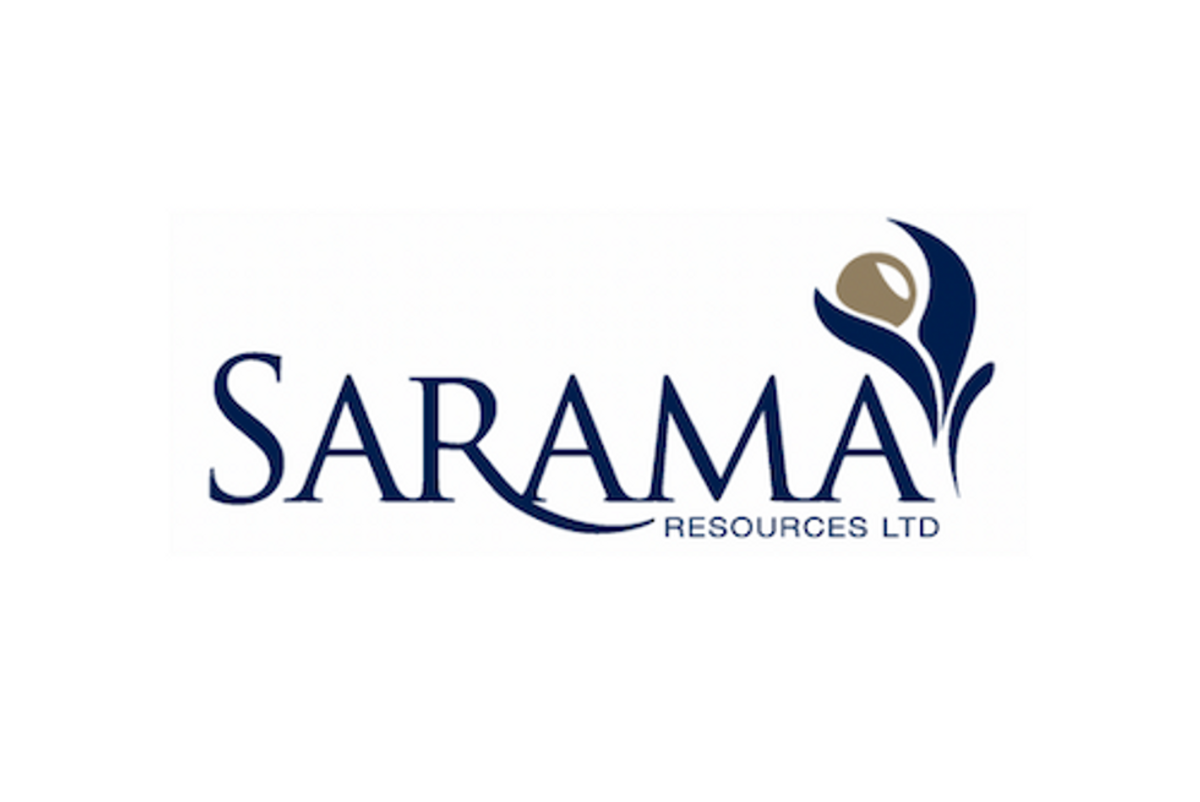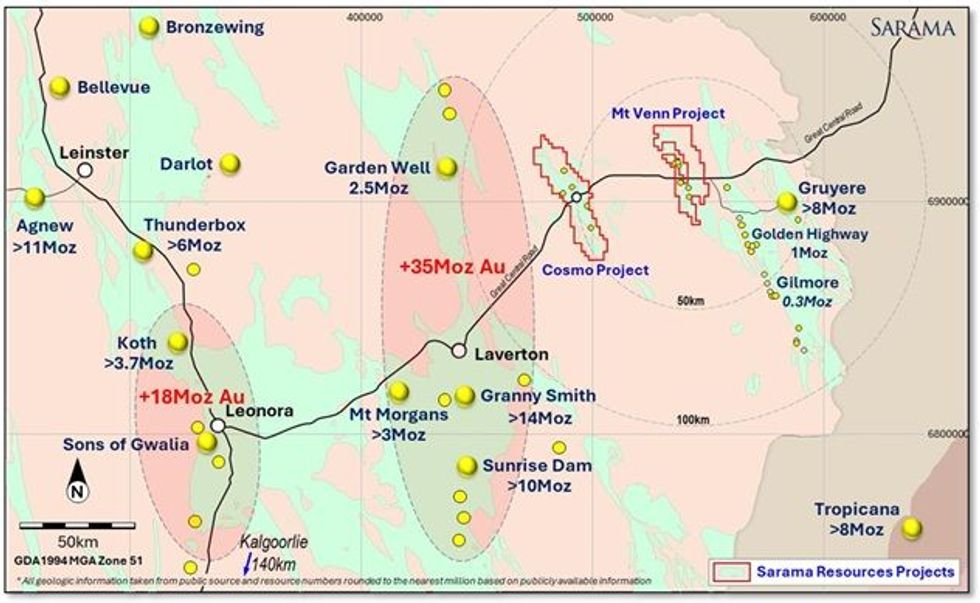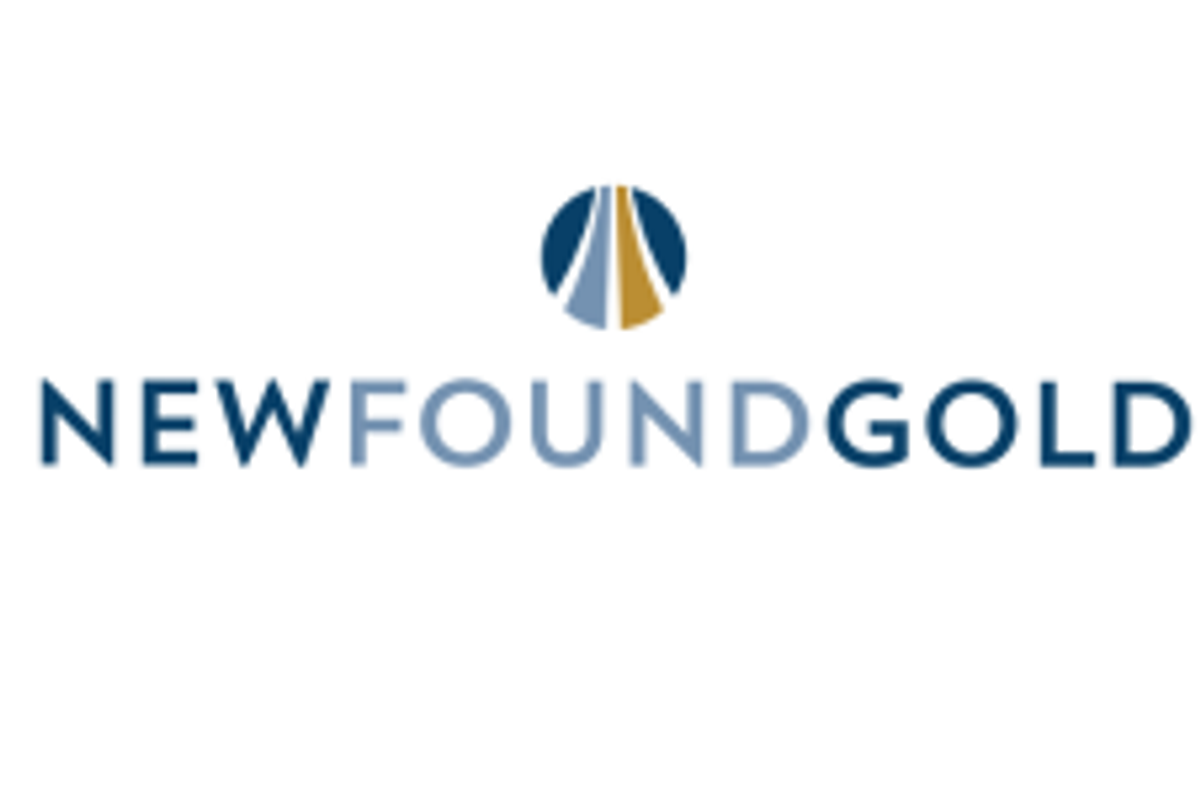
- NORTH AMERICA EDITIONAustraliaNorth AmericaWorld
February 26, 2025
Binding Agreement Executed for Acquisition of Majority Interest (1) in Belt-Scale Gold Project
Sarama Resources Ltd. (“Sarama” or the “Company”) (ASX:SRR, TSX- V:SWA) is pleased to advise that it has reached binding agreement (the “Agreement”) with Orbminco Limited (“Orbminco”) (ASX: OB1), an arm’s length third party, to acquire a majority(1) and controlling interest(1) in the under- explored, belt-scale 420km² Mt Venn Project (the “Project”)(2), located in the Eastern Goldfields of Western Australia.
This follows Sarama’s recent acquisition of a majority interest in the nearby Cosmo Project (refer Sarama news release 6 December 2024). Together the projects create a 1,000km² well-positioned and underexplored landholding in the Laverton Gold District which is known for its prolific gold endowment (refer Figure 1) and recent discoveries.
Highlights
- Binding agreement executed for acquisition of 80% interest in belt-scale Mt Venn Project
- Located in the prolific Laverton Gold District, 35km from the producing Gruyere Gold Mine and less than 20km from Gold Road’s Golden Highway Deposit
- Project covers 420km² and features a favourable litho-structural setting, primarily in greenstone rocks
- Includes regional shear zone of ~50km strike length and 1-3km width extending full length of greenstone belt
- Advanced gold targets generated through historical exploration, including broad drill-defined gold mineralisation
- Highly complementary to Sarama’s recently acquired, underexplored and prospective Cosmo Project
- Creates 1,000km² exploration position in the Laverton Gold District, capturing 100km of strike length
- Land access agreement with Traditional Owners in place for exploration
- 100% scrip consideration with initial exploration funded by the November 2024 equity raise of A$2M
Sarama’s President, Executive Chairman, Andrew Dinning commented:
“We are very pleased to be nearing completion of the acquisition a majority interest in the Mt Venn Project and consolidating our position in the prolific Laverton Gold District of Western Australia. The addition of the Mt Venn Project will create a major 1,000km2 area-play and significantly enhances the probability of making the next big discovery in a region that continues to deliver new deposits in previously unexplored areas, including the regionally significant Gruyere Deposit just 35km east of the Mt Venn Project. Soil sampling programs at the Cosmo Project are progressing well, feeding into the process of bringing the Cosmo and Mt Venn Projects to account as expeditiously as we can.”
Mt Venn Project
The Project is comprised of 3 contiguous exploration tenements covering approximately 420km² in the Eastern Goldfields of Western Australia, approximately 110km north-east of Laverton and 35km west of the regionally- significant Gruyere Gold Mine(3). The Project is readily accessible via the Great Central Road which services the regional area east of Laverton.
The Project captures the majority of the underexplored Jutson Rocks Greenstone Belt over a strike length of ~50km. Rocks within the belt feature a diverse sequence of volcanic lithologies of varying composition, together with pyroclastics and metasediments. Several internal intrusive units have been identified throughout the Project and are commonly associated with local structural features. A regionally extensive shear zone, spanning 1-3km in width, extends the entire length of the belt with subordinate splays interpreted in the southern area of the Project which provides a favourable structural setting for mineralisation.
Gold mineralisation was first discovered in the 1920’s with sampling returning very high grades and prompting the commencement of small-scale mining operations in the mid 1920’s. Multiple gold occurrences have since been identified throughout the Project, demonstrating the prospectivity of the system. Despite the identification of several km-scale gold-in-soil anomalies by soil geochemistry and auger drilling, many of these targets are yet to be properly tested. Encouragingly, drilling by Cazaly Resources Limited (“Cazaly”) (ASX: CAZ) at the Project intersected broad, gold mineralisation over several fences in weathered and fresh rock at the Three Bears Prospect, presenting a priority target for exploration (Cazaly news release 27 February 2017: “Widespread Gold & Zinc Mineralisation Defined”).
In addition to the attractiveness of the Project for gold, it is considered prospective for base metals and platinum group elements. Historical exploration work including auger geochemistry and geophysical surveys identified numerous targets for copper, nickel and zinc mineralisation. Several of these targets remain untested due to historical funding and land access constraints. Exploration in the belt to the immediate south of the Project area is noted to have intersected copper mineralisation of significant grade over a significant strike length(4).
In summary, the Project is located within a prolific gold district and has a favourable lithological and structural setting. A solid database of base-level historical exploration work by previous operators, including generation of drill-ready targets, provides a good platform for Sarama to advance the Project in conjunction with its activities at the Cosmo Project. The size and prospectivity of the landholding that Sarama will have in the Laverton Gold District upon completion of this transaction significantly enhances the chances of making an economic discovery, particularly given the infrastructure and proliferation of mines in the region which will have a favourable impact on the size threshold for finding something of economic value.

Click here for the full ASX Release
This article includes content from Sarama Resources, licensed for the purpose of publishing on Investing News Australia. This article does not constitute financial product advice. It is your responsibility to perform proper due diligence before acting upon any information provided here. Please refer to our full disclaimer here.
SRR:AU

Sign up to get your FREE
Sarama Resources Investor Kit
and hear about exciting investment opportunities.
- Corporate info
- Insights
- Growth strategies
- Upcoming projects
GET YOUR FREE INVESTOR KIT
The Conversation (0)
04 November
Sarama Resources
Promising new gold projects in Western Australia, plus a large fully funded arbitration claim.
Promising new gold projects in Western Australia, plus a large fully funded arbitration claim. Keep Reading...
02 December
Sarama Partners With InvestorHub to Strengthen Investor Engagement
VANCOUVER, BRITISH COLUMBIA / ACCESS Newswire / December 2, 2025 / Sarama Resources Ltd. ("Sarama" or the "Company")(TSX-V:SWA)(ASX:SRR) is pleased to announce that it has partnered with InvestorHub and launched a new interactive website, a direct-to-investor engagement platform ("Investor Hub"... Keep Reading...
03 November
Sarama Files Memorial in US$242M Damages Claim Against Burkina Faso
VANCOUVER, BRITISH COLUMBIA / ACCESS Newswire / November 3, 2025 / Sarama Resources Ltd. ("Sarama" or the "Company") (TSX-V:SWA)(ASX:SRR) announces that it has filed its written Memorial (the "Memorial") detailing the Company's claim against the Government of Burkina Faso ("GoBF") as well as... Keep Reading...
03 November
Sarama Files Memorial in US$242M Damages Claim Against Burkina Faso
Sarama Resources Ltd. (“Sarama” or the “Company”) (TSX-V:SWA, ASX:SRR) announces that it has filed its written Memorial (the “Memorial”) detailing the Company’s claim against the Government of Burkina Faso (“GoBF”) as well as damages for the sum of US$242 million, plus interest. The proceedings... Keep Reading...
20 October
Sarama Completes Tranche 3 Placement & Cleansing Notice
Sarama Resources Ltd. (“Sarama” or the “Company”) (TSX-V:SWA, ASX:SRR) advises that on 21 October 2025, it completed the third tranche of the previously announced A$2.7m equity placement (the “Placement”) (refer to Sarama’s news releases dated 30 June 2025 and 10 July 2025). The third tranche of... Keep Reading...
06 October
Sarama Completes Tranche 2 Placement and Broker Options
Sarama Resources Ltd. (“Sarama” or the “Company”) (TSX-V:SWA, ASX:SRR) is pleased to report that on 7 October 2025, it completed the second tranche of the previously announced A$2.6m equity placement (the “Placement”) (refer to Sarama’s news releases dated 30 June 2025 and 10 July 2025). The... Keep Reading...
24 December
What Was the Highest Price for Gold?
Gold has long been considered a store of wealth, and the price of gold often makes its biggest gains during turbulent times as investors look for cover in this safe-haven asset.The 21st century has so far been heavily marked by episodes of economic and sociopolitical upheaval. Uncertainty has... Keep Reading...
24 December
Blackrock Silver Announces C$15 Million Strategic Investment by Two Cornerstone Purchasers
Blackrock Silver Corp. (TSXV: BRC,OTC:BKRRF) (OTCQX: BKRRF) (FSE: AHZ0) ("Blackrock" or the "Company") is pleased to announce a non-brokered private placement (the "Offering") of up to 13,636,363 units (the "Units") at a price of C$1.10 per Unit for gross proceeds of up to C$15,000,000. Each... Keep Reading...
24 December
Gold Price Hits New Record, Breaks US$4,500; Silver, Platinum Also at All-time Highs
Gold marked a new price milestone on Tuesday (December 23), continuing its record-breaking 2025 run. The spot price rose as high as US$4,511.83 per ounce, hitting that point at 4:04 p.m. PST. Don't forget to follow us @INN_Resource for real-time updates!Securities Disclosure: I, Charlotte... Keep Reading...
23 December
From Gold Coins to Copper Tools: Unique Festive Gifts for the Metals Investor
With pumpkin spice in the air, thoughts are turning to the biggest event of the year… No, not the curling championships — Black Friday and the start of the gifting season.Here at the Investing News Network, our team aims to provide relevant information to help readers make informed investment... Keep Reading...
22 December
TomaGold Intercepts 6.68% ZnEq (1.57 g/t AuEq) over 48.05 Metres, including 39.03% ZnEq (9.15 g/t AuEq) over 2.90 Metres at Berrigan Mine and Identifies a Major Hydrothermal Footprint
TOMAGOLD CORPORATION (TSXV: LOT; OTCPK: TOGOF) (“TomaGold” or the “Company”) is very pleased to announce the initial assay results from drill holes TOM-25-009 and TOM-25-010 at its Berrigan Mine project located in the Chibougamau mining camp, in Québec. These are the first two of seven holes for... Keep Reading...
Latest News

Sign up to get your FREE
Sarama Resources Investor Kit
and hear about exciting investment opportunities.
- Corporate info
- Insights
- Growth strategies
- Upcoming projects
GET YOUR FREE INVESTOR KIT
Interactive Chart
Latest Press Releases
Steadright Grants Stock Options
24 December
Silverco Confirms No Material Change
24 December
Related News
TOP STOCKS
American Battery4.030.24
Aion Therapeutic0.10-0.01
Cybin Corp2.140.00







